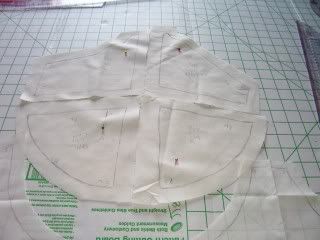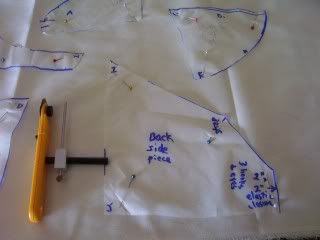Hi! So sorry I have not posted in a long time. I have made some new pattern pieces for the bullet bra, but alas, my health is not that great, for those of you who know me, so I haven't gotten very far on that project
YET.
*********************************************************************************
Today's Thanksgiving Day post will be on the topic of the mythical Pink Atlas Sewing machine. The Pink Atlas sewing machine is a 1950's industrial strength type of home sewing machine. The best part about this sewing machine is it is PINK. Yay! Hope you can see that in the font colors. The machine has one of the early external thread tension buttons, spools or knobs(?). You can hopefully see it there in the picture about 1/2" above the needle - a little silver tone round knob. I do not own this machine. The Pink Atlas sewing machine is super sturdy made of steel and other heavy duty components. It is a straight stitch machine. The Pink Atlas sewing machine weighs about 40 pounds or so. The motor is external and is belt driven.
It's not so easy to find these excellent sewing machines in working condition; however, there is a really cool
Youtube video where a nice lady shows how you can fairly easily convert your Pink Atlas sewing machine to a hand crank model. When you do that it sews so very quietly!
Why would you want to convert to a hand crank sewing machine? The EPA and the current administration in the United States is closing more and more coal-fired power plants as fast as they can. If you live in places where your electricity is made using coal-fired plants, get ready to have your electric bills either A. skyrocket! or B. the electric plant closed or C. Both!
Here are NiftyThrifty Girl's two videos on an older type of Pink Atlas Sewing machine.
Video 1 and you also need
Video 2 because she learned more about the machine as she went along.
This next photo below is of the "Rocketeer" sewing machine like
Jane Jetson might have used! (The picture below is also linked to wikipedia about the Jetsons cartoon).
It is the Singer Slant-O-Matic Model 500A. These glorious cam and gear driven sewing machines were manufactured in the early 1960's. Isn't it wonderful?! Check out BrianSews
blog here. And the Slant O Matic Fanatic
here.
Here is a picture of the Rocketeer in green. Isn't it divine? From what I understand, the Singer Slant-O-Matic 500A Rocketeer will sew about 30 different stitches using combinations of settings and metal cams, besides the basic straight stitch and zig-zag.
Niftythriftygirl sells her machines on eBay and below is a link to her YouTube video explaining all about the Singer Slant-O-Matic Rocketeer sewing machine that she had for sale in the past.
Click here for NiftyThriftyGirl's GREAT explanation about the Singer Slant-O-Matic Rocketeer model 500A.
What you really should think about investing in, if you are a free spirited sewist, is a spoked wheel attachment and a hand crank. These after market parts are made in China. They are not as smooth and nicely machined as original Singer models used, but they do work for most any sewing machine that has an external motor.
I am thinking of trying it on my New Home SS-2015 sewing machine: update: That would not have worked because my machine's motor is on the inside and it would have made the handcrank assembly too heavy.
Even though the motor is internal in the New Home SS-2015 - I'll just see about that! My first experiment was to turn the hand crank wheel on the right side when the power was completely off. I should have put a piece of fabric in there first -duh! Anyhow, the wheel turned smoothly and didn't seem to catch on anything at all! I was later able to remove the matted threads nest I had created below the needle plate or in the bobbin area.
If you don't want to go to the trouble of converting an existing mechanical sewing machine, (this won't work for the computerized models obviously, because there is no way to select your stitch without electricity nor can you change the stitch length or needle position, among other settings), is to just buy one of the beautiful antique treadle or hand crank sewing machines such as this Singer 66 model or "Red Eye" shown below without its table. I believe this machine is a treadle sewing machine. If you do buy one of the antique sewing machines BE SURE you have a wooden base for the hand crank model or, in the case of a treadle sewing machine, a treadle sewing machine table for it. It won't sew otherwise as there are gears and things on the underneath side that need to have empty space to work freely.

You can find the Pink Atlas Sewing machine on Etsy.com, eBay and other places. You can find the hand crank and spoked wheel after market attachments on eBay and other places on the internet. You can find the antique Singer and other brand sewing machines in either treadle or hand crank models on Etsy.com, eBay, flea markets, swap meets, garage sales, Estate sales, Craig's List, Antique shops and many other places.
Be sure to pick up a manual for your machine. If you don't have a manual or, like me, you lost yours, you can get one here from the following sellers:
http://www.sew4less.com/manuals.php
http://www.sewusa.com/Sewing_Machine_Instruction_Manuals.htm
Also on the sewusa.com website you can click on your sewing machine's manufacturer and, for some of them, they also include the service manual. This booklet can be invaluable. The pricing on the sewusa.com website is slightly lower, but not by much.
Or you may find sewing machine manuals in other places or eBay and Etsy.com.
Thank you for reading!
My shop on eBay.com
My shop on Etsy.com
























